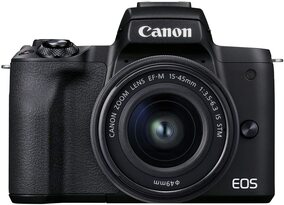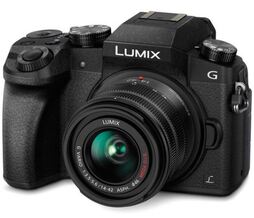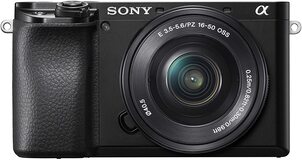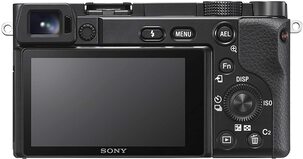Mirrorless Cameras-Compact System Cameras
What are Mirrorless Cameras?: Mirrorless cameras, which are also known as Compact System Cameras are the newest entry into the consumer digital camera market. They are also sometimes referred to as Interchangeable Lens Cameras.
Mirrorless Cameras are geared toward photographers who want the better image quality associated with Digital SLR cameras, but without the bulky size They are also built to appeal to those who like the smaller size of a Basic Compact Digital camera, but want the option of being able to change the camera lens to adapt to different picture taking situations.
This tutorial will review the major features of Mirrorless cameras as compared to Basic Compact cameras and Digital Slr cameras.
Smaller Camera Body Size: Many of the Mirrorless/Compact System cameras like the Canon EOS M50 Mark II and the the Panasonic Lumix DMC-G7 are close to the size of a typical compact camera, but are slightly larger and have larger sized lenses. Many also have a body shape similar to that of a Digital Slr camera with a hand grip but are lighter and more compact.
Mirrorless Cameras are geared toward photographers who want the better image quality associated with Digital SLR cameras, but without the bulky size They are also built to appeal to those who like the smaller size of a Basic Compact Digital camera, but want the option of being able to change the camera lens to adapt to different picture taking situations.
This tutorial will review the major features of Mirrorless cameras as compared to Basic Compact cameras and Digital Slr cameras.
Smaller Camera Body Size: Many of the Mirrorless/Compact System cameras like the Canon EOS M50 Mark II and the the Panasonic Lumix DMC-G7 are close to the size of a typical compact camera, but are slightly larger and have larger sized lenses. Many also have a body shape similar to that of a Digital Slr camera with a hand grip but are lighter and more compact.
The reason that Mirrorless Cameras/Compact System Cameras are smaller than Digital SLR cameras is that they do not have optical eye level viewfinders that are part of Digital SLR cameras. Optical viewfinders require a system that uses mirrors to view a scene.
One of the mirrors of the Digital SLR camera must flip up to allow light into the camera once the shutter release is pressed. The elimination of the mirror system allows the compact system cameras to be manufactured with smaller body sizes.
Just to be clear, basic compact cameras do not use mirror systems either. However, compact system cameras have most of the features that are found in Digital SLR cameras but are not found in basic compact cameras. Those features include larger image sensors as well as the ability to use different focal length lenses.
Electronic Viewfinders (EVFs): All Mirrorless Cameras have LCD screens for viewing the images, but many Mirrorless Cameras are also equipped with what are called Electronic View Finders (EVFs) for viewing and taking pictures at eye level.
The Sony Alpha a6100 is an example of a mirrorless camera with an Electronic Viewfinder. In addition to being able to view the scene, information about the scene such as exposure values and histograms may be shown in the electronic viewfinder. (the picture below on the right shows the EVF in the upper left hand corner of the camera)
One of the mirrors of the Digital SLR camera must flip up to allow light into the camera once the shutter release is pressed. The elimination of the mirror system allows the compact system cameras to be manufactured with smaller body sizes.
Just to be clear, basic compact cameras do not use mirror systems either. However, compact system cameras have most of the features that are found in Digital SLR cameras but are not found in basic compact cameras. Those features include larger image sensors as well as the ability to use different focal length lenses.
Electronic Viewfinders (EVFs): All Mirrorless Cameras have LCD screens for viewing the images, but many Mirrorless Cameras are also equipped with what are called Electronic View Finders (EVFs) for viewing and taking pictures at eye level.
The Sony Alpha a6100 is an example of a mirrorless camera with an Electronic Viewfinder. In addition to being able to view the scene, information about the scene such as exposure values and histograms may be shown in the electronic viewfinder. (the picture below on the right shows the EVF in the upper left hand corner of the camera)
Larger Image Sensor/Better Image Quality: The image sensors in Mirrorless Cameras/Compact System cameras are larger than those found in basic compact cameras. Larger image sensors have larger pixels and are able to process information about the light in a scene more accurately than a smaller image sensor. The result is better image quality.
Many Mirrorless cameras have the same size image sensor that is found in entry level Digital SLR cameras. For instance the Canon EOS M50 Mark II camera that was previously mentioned has an APS-C size sensor (22.3 X 14.9 mm) which is just about the same size image sensor found in the Canon Rebel EOS T7i Digital SLR camera.
The sizes of the camera image sensors found in Compact System Cameras are varied depending on the manufacturer of the camera. For instance, the Olympus line of Mirrorless Cameras are equipped with image sensors that measure 17.3 X 13.0 mm. That size is know as a Micro 4/3 image sensor.
The Panasonic DMC G7 mirrorless camera that was previously mentioned has a Micro 4/3 image sensor as well.
Although the size of the image sensors found in Mirrorless Cameras may vary, the image quality produced by any of the Mirrorless cameras should be better than that of a basic compact camera. (that is with all other things being equal)
Interchangeable Lenses: The option to change the camera lens is another advantage that Mirrorless/ Interchangeable Lens cameras have over basic compact cameras. This is a great feature because some photographers prefer to use certain types of lenses to fit a particular picture taking situation. (Sometimes the lens that comes with a camera might not always be the best choice for a particular scene.)
The lenses for Interchangeable Lens/Compact System cameras are smaller and lighter than the lenses made for Digital SLR cameras. Interchangeable Lens cameras are relatively new to the camera market and there are not as many lens choices available for them as there are for Digital SLR cameras.
However, there are lens adapters on the market which make it possible for a manufacturer's Digital SLR lenses to fit the Interchangeable Lens camera. (but some features of DSLR lenses, like autofocus, might not work properly when using certain adapters with the mirrorless camera. It will depend on the particular lens and adapter.) Also, using a larger lens on the mirrorless camera takes a little something away from the "compactness" of the camera.
Exposure Controls: All of the Interchangeable Lens cameras have shooting modes that allow you to have more control over the exposure settings that you can use, the same as with a Digital SLR Camera. These modes include Full Manual, Aperture Priority, Shutter Priority, and Program Modes.
If you don't feel like setting the exposure values, all compact system cameras come with a full automatic mode as well.
Please check the the Digital Camera Shooting Modes or Camera Exposure Basics tutorials if you are not familiar with using the semi-automatic or manual settings in a digital camera.
Flash/Hotshoe Attachment: Many of the Mirrorless Cameras like the Sony Alpha a6100 which was mentioned earlier have a built in pop up flash to use when there is not enough light to get the proper exposure for a picture. Some Mirrorless cameras including the the Sony Alpha a6100 will also have a hotshoe attachment which will allow you to attach an external flash.
So to summarize, the main features of Mirrorless cameras are that you get a somewhat compact camera that can produce Digital SLR quality images. You also have a choice of various camera lenses that can be used.
If you think the Mirrorless camera is a little more than you need in a camera, maybe a Basic Compact Digital Camera or a Bridge Camera might be better for you.
If you like the qualities of the Mirrorless camera, and the compact size isn't that important to you, then a Digital Single Lens Reflex camera with more lens choices and more choices of cameras with larger sensors might work for you.
Hopefully this review of the Mirrorless Camera/Compact System camera features will help you make a decision on the best type of camera for you.
Many Mirrorless cameras have the same size image sensor that is found in entry level Digital SLR cameras. For instance the Canon EOS M50 Mark II camera that was previously mentioned has an APS-C size sensor (22.3 X 14.9 mm) which is just about the same size image sensor found in the Canon Rebel EOS T7i Digital SLR camera.
The sizes of the camera image sensors found in Compact System Cameras are varied depending on the manufacturer of the camera. For instance, the Olympus line of Mirrorless Cameras are equipped with image sensors that measure 17.3 X 13.0 mm. That size is know as a Micro 4/3 image sensor.
The Panasonic DMC G7 mirrorless camera that was previously mentioned has a Micro 4/3 image sensor as well.
Although the size of the image sensors found in Mirrorless Cameras may vary, the image quality produced by any of the Mirrorless cameras should be better than that of a basic compact camera. (that is with all other things being equal)
Interchangeable Lenses: The option to change the camera lens is another advantage that Mirrorless/ Interchangeable Lens cameras have over basic compact cameras. This is a great feature because some photographers prefer to use certain types of lenses to fit a particular picture taking situation. (Sometimes the lens that comes with a camera might not always be the best choice for a particular scene.)
The lenses for Interchangeable Lens/Compact System cameras are smaller and lighter than the lenses made for Digital SLR cameras. Interchangeable Lens cameras are relatively new to the camera market and there are not as many lens choices available for them as there are for Digital SLR cameras.
However, there are lens adapters on the market which make it possible for a manufacturer's Digital SLR lenses to fit the Interchangeable Lens camera. (but some features of DSLR lenses, like autofocus, might not work properly when using certain adapters with the mirrorless camera. It will depend on the particular lens and adapter.) Also, using a larger lens on the mirrorless camera takes a little something away from the "compactness" of the camera.
Exposure Controls: All of the Interchangeable Lens cameras have shooting modes that allow you to have more control over the exposure settings that you can use, the same as with a Digital SLR Camera. These modes include Full Manual, Aperture Priority, Shutter Priority, and Program Modes.
If you don't feel like setting the exposure values, all compact system cameras come with a full automatic mode as well.
Please check the the Digital Camera Shooting Modes or Camera Exposure Basics tutorials if you are not familiar with using the semi-automatic or manual settings in a digital camera.
Flash/Hotshoe Attachment: Many of the Mirrorless Cameras like the Sony Alpha a6100 which was mentioned earlier have a built in pop up flash to use when there is not enough light to get the proper exposure for a picture. Some Mirrorless cameras including the the Sony Alpha a6100 will also have a hotshoe attachment which will allow you to attach an external flash.
So to summarize, the main features of Mirrorless cameras are that you get a somewhat compact camera that can produce Digital SLR quality images. You also have a choice of various camera lenses that can be used.
If you think the Mirrorless camera is a little more than you need in a camera, maybe a Basic Compact Digital Camera or a Bridge Camera might be better for you.
If you like the qualities of the Mirrorless camera, and the compact size isn't that important to you, then a Digital Single Lens Reflex camera with more lens choices and more choices of cameras with larger sensors might work for you.
Hopefully this review of the Mirrorless Camera/Compact System camera features will help you make a decision on the best type of camera for you.





